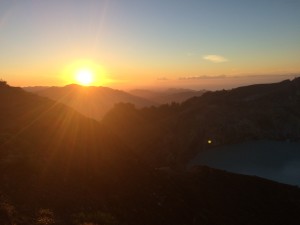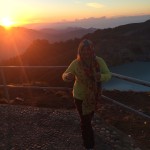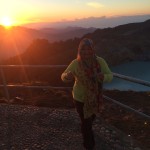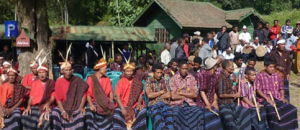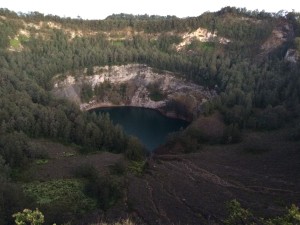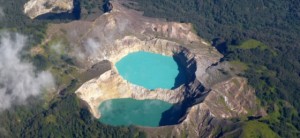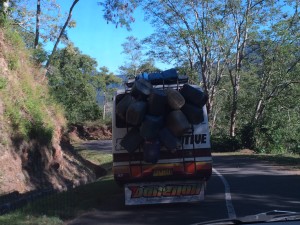Flores is my Indonesia swan song – my last major trip in the archipelago nation before heading back to the U.S. I’m just barely staying true to Weekend Crossroad’s philosophy, as between its immense size and still developing infrastructure, Flores requires considerably more a long weekend to explore properly. However, those with time constraints can always choose a couple of highlights to enjoy, as illustrated in the following multi-part Flores series. Alternatively, one can choose to take an 8-10 day overland trip from Maumere to Labuan Bajo, which covers roughly two-thirds of the island.
This is Part three of eight. Check out Part one, Flores 101: How, When and Why to Go, and Part two, Flores: Singing and Swaying in Sikka.
Mount Kelimutu – “the Boiling Mountain” – is one of Flores’ must see attractions, both for the ethereal natural beauty surrounding its three colored crater lakes, and the mythical beliefs held by local inhabitants. Seeing the volcanoes at sunrise is a MUST – particularly since, unlike most Indonesian sunrise vistas, there are surprisingly few tourists present on weekdays, affording one a unique opportunity to enjoy nature’s broad palette.
Science
Like Lake Toba, Mount Kelimutu has both scientific and, well, not-so-scientific explanations for its creation, the ever-evolving hues of its crater lakes, and its greater purpose.
Scientifically, relatively less is known about Kelimutu than its other cousins such as Toba and Krakatau. Nearly 1,700 meters at its peak, the volcano was “discovered” in 1915 by a Dutch colonial government official. Since then, three major eruptions have been recorded – 1928, 1938, and a massive eruption in 1968 during which water from the crater lakes was projected as high as ten meters. There have been periodically heightened periods of activity over the last 20 years, but nothing nearly at these levels.
The highly acidic lakes – though beguiling – can also be lethal. In 1995 a Dutch tourist fell into the turquoise lake – and despite 5 days of search and rescue – was never found. I had to chuckle when “Kelimutu lakes swimming” was one of the Google autofill options that came up as I was researching the area. That, my friends, would not be a good idea.
Superstition
Kelimutu is considered sacred by the Lio tribe as it is believed that souls of the dead reside in the deep waters. They begin their journey at the Gate of the Spirits marked by two huge rocks symbolizing the Konde (or queen) and Ratu (or king). These guards of the gate (a sort of Florinese St. Peter if you will) assign souls to the appropriate lake based on two key criteria – their age at time of death, and the nature of their character.
- The elderly are sent to Tiwi Ata Mbupu, which stands alone.
- The young, naturally, are sent to warm and bright Tiwu Nuwa Muri Koo Fai (back), while the wicked are consigned to the cold depths of Tiwu Ata Polo (foreground). Image courtesy of www.florestourism.com
Every year in August, a ceremony is held to commemorate the souls of the departed and ask for blessings and safe passage through Kelimutu in the year to come.
I learn that many of the island’s traditional belief systems are built on a delicate balance between “complementary opposites” – male/female, old/young, sky/earth, mountain/sea, etc. Spirits, generally benevolent ancestors, serve as guardians and protectors, while every once in a while, an evil spirit lurks around, leaving misfortune, destruction, illness, and death in its wake. Both groups are honored / appeased with frequent offerings.
Kelimutu is essentially a giant tempat angker, or “haunted place” where spirits gather – one of many found throughout the island. To manage these forces, each village has a dukun, or healer who through a combination of traditional medicine and ritual practices can either call up white magic for good, or black magic for bad.
Setting
The drive up in complete darkness can be a little unnerving, with sudden sharp curves, steep inclines, and eerie mists all limiting visibility. It is difficult to believe, as in much of Flores, that these are meant to be two-way streets – and the sudden appearance of headlights requires a graceful automotive dance that only the most skilled of drivers can pull off.
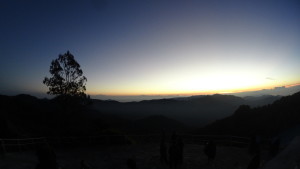 It is a bit of a hike to get to the top – 1.5 km of a relatively gentle slope followed by 127 steps to the viewing platform at the summit. All in all highly doable for people even at less than prime levels of fitness (such as yours truly). The walk up – in nearly pitch black – is almost other worldly, and frequently described by travel writers as a virtual moonscape. At the first blush of dawn, however, the vista is transformed in a way that is impossible to capture on camera. Upon reaching the viewpoint summit, the morning chill begins to sink into your bones. Fear not, however, as enterprising locals lay out blankets offering everything from tantalizingly hot ginger coffee to extra sarongs for warmth.
It is a bit of a hike to get to the top – 1.5 km of a relatively gentle slope followed by 127 steps to the viewing platform at the summit. All in all highly doable for people even at less than prime levels of fitness (such as yours truly). The walk up – in nearly pitch black – is almost other worldly, and frequently described by travel writers as a virtual moonscape. At the first blush of dawn, however, the vista is transformed in a way that is impossible to capture on camera. Upon reaching the viewpoint summit, the morning chill begins to sink into your bones. Fear not, however, as enterprising locals lay out blankets offering everything from tantalizingly hot ginger coffee to extra sarongs for warmth.
On the walk back, nature’s sounds and scents greet you as the moonscape comes alive. The drive back is harrowing for an entirely different reason — morning fog not only obscures the car’s windshield, but also makes it very hard to see beyond a couple of meters at a time. Somehow, we make it back to the Kelimutu Ecolodge in one piece, in time for a well-deserved breakfast.
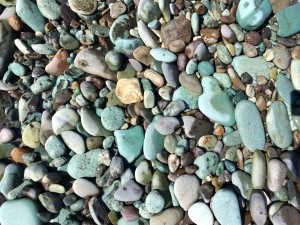 Our next stop is Penggajawa Beach, popularly known as Blue Stone Beach, in Ende. My initial reaction is slight disappointment — after the spectacularly gorgeous beaches that I’ve seen in other parts of Flores, this semi-industrial port-meets-stone-quarry stop is underwhelming. I enjoy getting up close and personal with the beach, and pick up a few small blue stones to replace my goddaughter’s mysteriously vanished mancala game stones back home. But high demand for the stones from interior designers across Indonesia and in Japan means that the once vibrantly blue beach is becoming whiter and grayer. 🙁
Our next stop is Penggajawa Beach, popularly known as Blue Stone Beach, in Ende. My initial reaction is slight disappointment — after the spectacularly gorgeous beaches that I’ve seen in other parts of Flores, this semi-industrial port-meets-stone-quarry stop is underwhelming. I enjoy getting up close and personal with the beach, and pick up a few small blue stones to replace my goddaughter’s mysteriously vanished mancala game stones back home. But high demand for the stones from interior designers across Indonesia and in Japan means that the once vibrantly blue beach is becoming whiter and grayer. 🙁
We then hit a bit of a snag. Heading out from the beach, we discover that the highway is closed for an undetermined amount of time due to construction. (This is a common occurrence across the island, incidentally.) So we pull to the side of the road, where I engage in one of my favorite Indonesian activities — truck spotting.
- The Rastafarian movement is alive and well in Indonesia, particularly in North Sumatra and Flores.
- This is a painstakingly rendered Messi, though a slight paint mishap gives him an almost canibalistic likeness.
- No more room? No problem. A minibus maximizes ALL possible space.
At long last our journey finally resumes — next stop, Riung and the 17 Islands!
Continue on to part 4 here.







